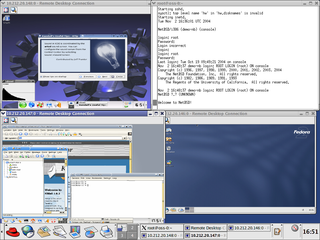Related Research Articles

A rootkit is a collection of computer software, typically malicious, designed to enable access to a computer or an area of its software that is not otherwise allowed and often masks its existence or the existence of other software. The term rootkit is a compound of "root" and the word "kit". The term "rootkit" has negative connotations through its association with malware.

Antivirus software, also known as anti-malware, is a computer program used to prevent, detect, and remove malware.

Xen is a type-1 hypervisor, providing services that allow multiple computer operating systems to execute on the same computer hardware concurrently. It was originally developed by the University of Cambridge Computer Laboratory and is now being developed by the Linux Foundation with support from Intel, Citrix, Arm Ltd, Huawei, AWS, Alibaba Cloud, AMD, Bitdefender and epam.
A hypervisor is a type of computer software, firmware or hardware that creates and runs virtual machines. A computer on which a hypervisor runs one or more virtual machines is called a host machine, and each virtual machine is called a guest machine. The hypervisor presents the guest operating systems with a virtual operating platform and manages the execution of the guest operating systems. Unlike an emulator, the guest executes most instructions on the native hardware. Multiple instances of a variety of operating systems may share the virtualized hardware resources: for example, Linux, Windows, and macOS instances can all run on a single physical x86 machine. This contrasts with operating-system–level virtualization, where all instances must share a single kernel, though the guest operating systems can differ in user space, such as different Linux distributions with the same kernel.
HoneyMonkey, short for Strider HoneyMonkey Exploit Detection System, is a Microsoft Research honeypot. The implementation uses a network of computers to crawl the World Wide Web searching for websites that use browser exploits to install malware on the HoneyMonkey computer. A snapshot of the memory, executables and registry of the honeypot computer is recorded before crawling a site. After visiting the site, the state of memory, executables, and registry is recorded and compared to the previous snapshot. The changes are analyzed to determine if the visited site installed any malware onto the client honeypot computer.

Joanna Rutkowska is a Polish computer security researcher, primarily known for her research on low-level security and stealth malware, and as founder of the Qubes OS security-focused desktop operating system.
Blue pill may refer to:

In computer science, virtualization is a modern technique developed in late 1990s and is different from simulation and emulation. Virtualization employs techniques used to create instances of an environment, as opposed to simulation, which models the environment; or emulation, which replicates the target environment such as certain kinds of virtual machine environments. Full virtualization requires that every salient feature of the hardware be reflected into one of several virtual machines – including the full instruction set, input/output operations, interrupts, memory access, and whatever other elements are used by the software that runs on the bare machine, and that is intended to run in a virtual machine. In such an environment, any software capable of execution on the raw hardware can be run in the virtual machine and, in particular, any operating systems. The obvious test of full virtualization is whether an operating system intended for stand-alone use can successfully run inside a virtual machine.
Torpig, also known as Anserin or Sinowal is a type of botnet spread through systems compromised by the Mebroot rootkit by a variety of trojan horses for the purpose of collecting sensitive personal and corporate data such as bank account and credit card information. It targets computers that use Microsoft Windows, recruiting a network of zombies for the botnet. Torpig circumvents antivirus software through the use of rootkit technology and scans the infected system for credentials, accounts and passwords as well as potentially allowing attackers full access to the computer. It is also purportedly capable of modifying data on the computer, and can perform man-in-the-browser attacks.
Michael Gregory Hoglund is an American author, researcher, and serial entrepreneur in the cyber security industry. He is the founder of several companies, including Cenzic, HBGary and Outlier Security. Hoglund contributed early research to the field of rootkits, software exploitation, buffer overflows, and online game hacking. His later work focused on computer forensics, physical memory forensics, malware detection, and attribution of hackers. He holds a patent on fault injection methods for software testing, and fuzzy hashing for computer forensics. Due to an email leak in 2011, Hoglund is well known to have worked for the U.S. Government and Intelligence Community in the development of rootkits and exploit material. It was also shown that he and his team at HBGary had performed a great deal of research on Chinese Government hackers commonly known as APT. For a time, his company HBGary was the target of a great deal of media coverage and controversy following the 2011 email leak. HBGary was later acquired by a large defense contractor.
Alureon is a trojan and bootkit created to steal data by intercepting a system's network traffic and searching for banking usernames and passwords, credit card data, PayPal information, social security numbers, and other sensitive user data. Following a series of customer complaints, Microsoft determined that Alureon caused a wave of BSoDs on some 32-bit Microsoft Windows systems. The update, MS10-015, triggered these crashes by breaking assumptions made by the malware author(s).
Second Level Address Translation (SLAT), also known as nested paging, is a hardware-assisted virtualization technology which makes it possible to avoid the overhead associated with software-managed shadow page tables.
ZeroAccess is a Trojan horse computer malware that affects Microsoft Windows operating systems. It is used to download other malware on an infected machine from a botnet while remaining hidden using rootkit techniques.

Qubes OS is a security-focused desktop Linux distribution that aims to provide security through isolation. Virtualization is performed by Xen, and user environments can be based on Fedora, Debian, Whonix, and Microsoft Windows, among other operating systems.
Absolute Home & Office is a proprietary laptop theft recovery software. The persistent security features are built into the firmware of devices. Absolute Home & Office has services of an investigations and recovery team who partners with law enforcement agencies to return laptops to their owners. Absolute Software licensed the name LoJack from the vehicle recovery service LoJack in 2005.

The Intel Management Engine (ME), also known as the Intel Manageability Engine, is an autonomous subsystem that has been incorporated in virtually all of Intel's processor chipsets since 2008. It is located in the Platform Controller Hub of modern Intel motherboards.
Pin control attack is a class of attack against a system on a chip (SoC) in an embedded system where an attacker targets the I/O configuration of the embedded systems and disables software or operating system I/O functions without detection. The attack is possible due to a lack of hardware protection for pin configuration and pin multiplexing configurations.

Meltdown is a hardware vulnerability affecting Intel x86 microprocessors, IBM POWER processors, and some ARM-based microprocessors. It allows a rogue process to read all memory, even when it is not authorized to do so.

Foreshadow, known as L1 Terminal Fault (L1TF) by Intel, is a vulnerability that affects modern microprocessors that was first discovered by two independent teams of researchers in January 2018, but was first disclosed to the public on 14 August 2018. The vulnerability is a speculative execution attack on Intel processors that may result in the disclosure of sensitive information stored in personal computers and third-party clouds. There are two versions: the first version (original/Foreshadow) targets data from SGX enclaves; and the second version (next-generation/Foreshadow-NG) targets virtual machines (VMs), hypervisors (VMM), operating systems (OS) kernel memory, and System Management Mode (SMM) memory. A listing of affected Intel hardware has been posted.

An evil maid attack is an attack on an unattended device, in which an attacker with physical access alters it in some undetectable way so that they can later access the device, or the data on it.
References
- ↑ King, S. T.; Chen, P. M. (2006). "SubVirt: implementing malware with virtual machines". 2006 IEEE Symposium on Security and Privacy (S&P'06). pp. 14 pp. doi:10.1109/SP.2006.38. ISBN 0-7695-2574-1. S2CID 1349303.
- ↑ 'Blue Pill' Prototype Creates 100% Undetectable Malware, Ryan Naraine, eWeek.com
- ↑ Faceoff: AMD vs. Joanna Rutkowska Archived 2008-05-04 at the Wayback Machine , eWeek.com
- ↑ Debunking Blue Pill Myth, virtualization.info
- ↑ "- Showdown at the Blue Pill Corral - eWeek Security Watch". Archived from the original on 2012-02-06. Retrieved 2007-08-20.
- ↑ Rutkowska faces ‘100% undetectable malware’ challenge, Ryan Naraine at zdnet.com Archived September 3, 2009, at the Wayback Machine
- ↑ Naraine, Ryan (2007-06-29). "Blue Pill hacker challenge update: It's a no-go". zdnet.com. ZDNet. Archived from the original on 2009-11-26. Retrieved 2016-01-24.
Rutkowska [...] wants her two-person team to be paid $384,000 ($200/hr each for two people working full-time for six months) [...] Matasano’s Thomas Ptacek, a member of the challenge team, provides this apt response: 'Why would we pay you $384,000 to buy a rootkit we already know we can detect?'
- ↑ Showdown at the Blue Pill Corral
- ↑ Blue Pill 2007 Archived October 5, 2009, at the Wayback Machine
- ↑ Blue Pill 2008 Archived September 13, 2011, at the Wayback Machine
- ↑ "bluepillproject.org". 18 April 2008. Archived from the original on 18 April 2008. Retrieved 3 September 2017.
{{cite web}}: CS1 maint: bot: original URL status unknown (link) - ↑ "Blog | the Invisible Things". Archived from the original on 2007-09-11. Retrieved 2007-09-11.